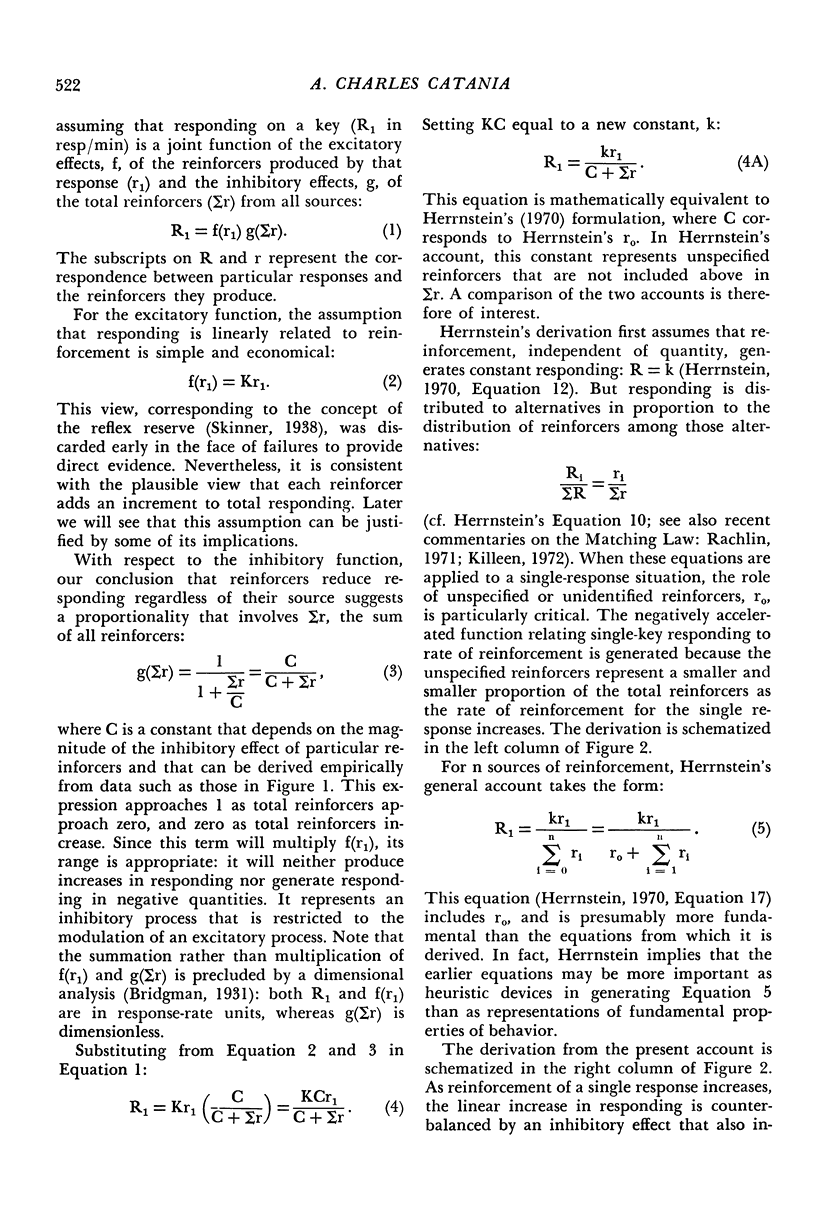Abstract
The reinforcers produced by one response reduce the rate of other, concurrently reinforced responses. An analysis of the logical and empirical implications of the relation indicates that one reinforcer must have this effect on responses maintained by other reinforcers even when all reinforcers are produced by the same class of responses. A quantitative expression of the relation leads to a formulation, mathematically equivalent to Herrnstein's (1970), in which the rate of a reinforced response is a joint function of (1) an excitatory effect of the reinforcers produced by that class of responses, and (2) an inhibitory effect of the total reinforcers produced both by that class and by other classes of responses.
Full text
PDF









Selected References
These references are in PubMed. This may not be the complete list of references from this article.
- CATANIA A. C. Concurrent performances: reinforcement interaction and response independence. J Exp Anal Behav. 1963 Apr;6:253–263. doi: 10.1901/jeab.1963.6-253. [DOI] [PMC free article] [PubMed] [Google Scholar]
- Catania A. C. Concurrent performances: inhibition of one response by reinforcement of another. J Exp Anal Behav. 1969 Sep;12(5):731–744. doi: 10.1901/jeab.1969.12-731. [DOI] [PMC free article] [PubMed] [Google Scholar]
- Catania A. C., Deegan J. F., Cook L. Concurrent fixed-ratio and avoidance responding in the squirrel monkey. J Exp Anal Behav. 1966 May;9(3):227–231. doi: 10.1901/jeab.1966.9-227. [DOI] [PMC free article] [PubMed] [Google Scholar]
- Catania A. C. Reinforcement schedules: the role of responses preceding the one that produces the reinforcer. J Exp Anal Behav. 1971 May;15(3):271–287. doi: 10.1901/jeab.1971.15-271. [DOI] [PMC free article] [PubMed] [Google Scholar]
- Catania A. C., Reynolds G. S. A quantitative analysis of the responding maintained by interval schedules of reinforcement. J Exp Anal Behav. 1968 May;11(3 Suppl):327–383. doi: 10.1901/jeab.1968.11-s327. [DOI] [PMC free article] [PubMed] [Google Scholar]
- Herrnstein R. J. On the law of effect. J Exp Anal Behav. 1970 Mar;13(2):243–266. doi: 10.1901/jeab.1970.13-243. [DOI] [PMC free article] [PubMed] [Google Scholar]
- Hollard V., Davison M. C. Preference for qualitatively different reinforcers. J Exp Anal Behav. 1971 Nov;16(3):375–380. doi: 10.1901/jeab.1971.16-375. [DOI] [PMC free article] [PubMed] [Google Scholar]
- Hovland C. I. Inhibition of Reinforcement' and Phenomena of Experimental Extinction. Proc Natl Acad Sci U S A. 1936 Jun;22(6):430–433. doi: 10.1073/pnas.22.6.430. [DOI] [PMC free article] [PubMed] [Google Scholar]
- Killeen P. The matching law. J Exp Anal Behav. 1972 May;17(3):489–495. doi: 10.1901/jeab.1972.17-489. [DOI] [PMC free article] [PubMed] [Google Scholar]
- Lander D. G., Irwin R. J. Multiple schedules: effects of the distribution of reinforcements between component on the distribution of responses between conponents. J Exp Anal Behav. 1968 Sep;11(5):517–524. doi: 10.1901/jeab.1968.11-517. [DOI] [PMC free article] [PubMed] [Google Scholar]
- Nevin J. A., Shettleworth S. J. An analysis of contrast effects in multiple schedules. J Exp Anal Behav. 1966 Jul;9(4):305–315. doi: 10.1901/jeab.1966.9-305. [DOI] [PMC free article] [PubMed] [Google Scholar]
- RATLIFF F., HARTLINE H. K. The responses of Limulus optic nerve fibers to patterns of illumination on the receptor mosaic. J Gen Physiol. 1959 Jul 20;42(6):1241–1255. doi: 10.1085/jgp.42.6.1241. [DOI] [PMC free article] [PubMed] [Google Scholar]
- REYNOLDS G. S. Relativity of response rate and reinforcement frequency in a multiple schedule. J Exp Anal Behav. 1961 Apr;4:179–184. doi: 10.1901/jeab.1961.4-179. [DOI] [PMC free article] [PubMed] [Google Scholar]
- Rachlin H., Baum W. M. Effects of alternative reinforcement: does the source matter? J Exp Anal Behav. 1972 Sep;18(2):231–241. doi: 10.1901/jeab.1972.18-231. [DOI] [PMC free article] [PubMed] [Google Scholar]
- Rachlin H., Baum W. M. Response rate as a function of amount of reinforcement for a signalled concurrent response. J Exp Anal Behav. 1969 Jan;12(1):11–16. doi: 10.1901/jeab.1969.12-11. [DOI] [PMC free article] [PubMed] [Google Scholar]
- Rachlin H. On the tautology of the matching law. J Exp Anal Behav. 1971 Mar;15(2):249–251. doi: 10.1901/jeab.1971.15-249. [DOI] [PMC free article] [PubMed] [Google Scholar]
- Shimp C. P., Wheatley K. L. Matching to relative reinforcement frequency in multiple schedules with a short component duration. J Exp Anal Behav. 1971 Mar;15(2):205–210. doi: 10.1901/jeab.1971.15-205. [DOI] [PMC free article] [PubMed] [Google Scholar]
- Todorov J. C. Component duration and relative response rates in multiple schedules. J Exp Anal Behav. 1972 Jan;17(1):45–49. doi: 10.1901/jeab.1972.17-45. [DOI] [PMC free article] [PubMed] [Google Scholar]


